Vintage photograph depicting an American soldier running for cover while under fire in a Vietnamese city.
Time for another except from the Soldier’s Manual of Common Tasks, Warrior Skills, Level 1. Have you ever gone paintballing in the woods with people who have no tactical training of any sort? You may have noticed their inability to keep their heads down, the casual way the stroll through the trees like they’re back on the block, or their refusal to carry a weapon in some kind of ready position. Of course paintball does still have drawbacks from realism: first is the inability to differentiate between cover and concealment; twigs and grass will break up the paint projectile. Second is the range; without some very expensive equipment, the odds are you’ll not be dropping anyone at over 300 meters, and if you do manage the impossible your ball probably won’t break.
But even in the great paintball games, the ability to react and move under fire can keep you rolling and give you the split second edge over your opponent. In real life with an enemy shooter, your ability and conditioned movements are even more important.
For your info if you are unfamiliar here are some movement positions to know:
Low crawl: if your face isn’t dragging in the mud you’re not doing it right. This crawl gives you the lowest possible silhouette.
High crawl: faster than the low crawl but raising your silhouette.
The Rush: tell yourself “I’m up, he sees me, I’m down.” You moment of exposure should not be any longer. Once you hit the grown make sure you roll so that you do not start your next rush from the position you ended in; if a bad guy saw you go down he will likely be zeroed in on where he saw you last when you dropped behind cover.
Buddy Rush: the movement is like the single rush with the exception that your buddy is providing fire while you rush, and then you return the favor. Make sure you coordinate vocally as you rush; this is moving under direct fire, they know you are there and are shooting at or near you, so you had might as well shout. This is an option for closing in a on an enemy all the while keeping their heads down with suppressing fire.
Good luck:
Jon
071-326-0502
Move Under Direct Fire
Conditions: As a member of a two-man team, given a tactical situation where you must approach an enemy position from a distance of 250 to 300 meters across varied terrain; an M16A1 rifle or M203 grenade launcher; load-carrying equipment (LCE).
Standards: Move within 100 meters of the enemy position. Use the correct individual tactical fire and movement techniques dictated by terrain features. Coordinate movement with team members and provide covering fire for each member.
3-168 071-326-0502 18 June 2009 STP 21-1-SMCT
Performance Steps
1. Select an individual movement route within your team, or squad route or axis of advance (figure 071-326-0502-1).
Figure 071-326-0502-1. Individual movement route
a. Search the terrain to your front for—
(1) A gully, ravine, ditch, or wall at a slight angle to your direction of movement.
Note: These features provide cover and concealment when using the low or high crawl.
(2) Hedgerows or a line of thick vegetation.
Note: These features provide concealment only during the low or high crawl.
(3) Large trees, rocks, stumps, fallen timber, rubble, vehicle hulks, folds, or creases in the ground.
Note: These features provide cover and concealment for use as temporary positions. Use the rush if the area between them has no concealment.
(4) High grass or weeds.
Note: These features provide only partial concealment. You can use the rush because using the high or low crawl could move vegetation and reveal your location.
STP 21-1-SMCT 18 June 2009 071-326-0502 3-169
Performance Steps
b. Select your next position (and the route to it) as the one that—
(1) Exposes you to the least enemy fire.
(2) Does not require you to cross in front of other members of your element, masking their fires.
2. Determine the correct individual movement technique.
a. Select the high crawl when—
(1) The route provides cover and concealment.
(2) Poor visibility reduces enemy observation.
(3) Speed is required, but the terrain and vegetation are suitable only for the low crawl.
b. Select the low crawl when—
(1) The route provides cover or concealment less than 1 foot high.
(2) Visibility provides the enemy with good observation.
(3) Speed is not required.
c. Select the rush when—
(1) You must cross open areas.
(2) Time is critical.
3. Communicate the movement plan to your buddy or team leader using hand signals so that the Soldier not moving can cover by fire the other Soldier’s movement, if any.
Note: When moving as a member of a fire team, watch and listen to your team leader who will lead you along the best route available and ensure that covering fire is provided when you move. Stay with your team leader and follow his/her example.
4. Use the high crawl (figure 071-326-0502-2).
Figure 071-326-0502-2. High crawl
a. Keep your body off of the ground
b. Rest your weight on your forearms and lower legs.
3-170 071-326-0502 18 June 2009 STP 21-1-SMCT
Performance Steps
c. Cradle your weapon in your arms, keeping its muzzle off the ground.
d. Keep your knees well behind your buttocks, so your buttocks stays low.
e. Move forward by alternately advancing your right elbow and left knee, then your left elbow and right knee.
5. Use the low crawl (figure 071-326-0502-3).
Figure 071-326-0502-3. Low crawl
a. Keep your body as flat as possible to the ground.
b. Hold your weapon by grasping the sling at the upper sling swivel and letting the handguard rest on your forearm. Let the butt of the weapon drag on the ground. This will help you keep the muzzle off the ground.
c. Move forward by—
(1) Pushing both arms forward while pulling your right leg forward.
(2) Pulling with both arms while pushing with your right leg.
(3) Continuing this push-pull movement until you reach your next position, changing your pushing leg frequently to avoid fatigue.
STP 21-1-SMCT 18 June 2009 071-326-0502 3-171
Performance Steps
6. When enemy fire allows brief exposure, use the rush to move from one covered position to another (figure 071-326-0502-4).
Figure 071-326-0502-4. Rush
a. Move from your firing position by rolling or crawling.
b. Start from the prone position.
c. Slowly raise your head and select your next position.
d. Lower your head while at the same time drawing your arms into your body, elbows down, and pulling your right leg forward.
e. Raise your body in one movement by straightening your arms.
f. Spring to your feet, stepping off with either foot.
g. Run to the next position—
(1) Keep the distance short to avoid accurate enemy fire.
(2) Try not to stay up any longer tha1n 3 to 5 seconds so that the enemy does not have time to track you with automatic fire.
h. Plant both feet just before hitting the ground.
i. Fall forward by—
3-172 071-326-0503 18 June 2009 STP 21-1-SMCT
Performance Steps
(1) Sliding your right hand down to the heel of the butt of your weapon.
(2) Breaking your fall with the butt of your weapon.
j. Assume a firing position.
(1) Roll on your side.
(2) Place the butt of your weapon in the hollow of your shoulder.
(3) Roll or crawl to a covered or concealed firing position.
7. Cover your buddy’s movement with fire.
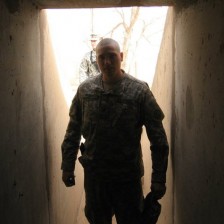
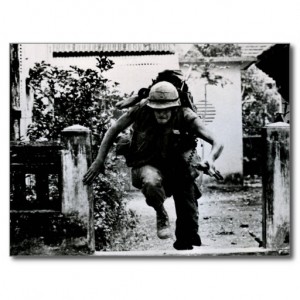
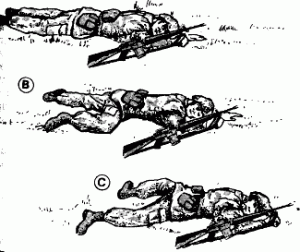

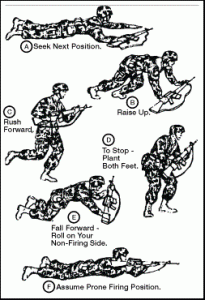
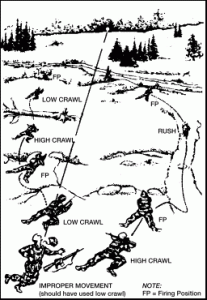
Leave a Reply